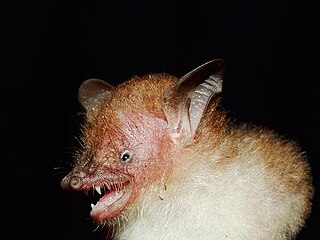
The fraternal myotis is a species of vesper bat native to East Asia.

The greater tube-nosed bat is a species of bat. An adult greater tube-nosed bat has a body length of 4.2-5.7 cm, a tail length of 3.6-4.1 cm, and a wing length of 3.7-4.4 cm. The species is found in India, Mongolia, China, and Korea.

Murina is a genus of vesper bats. They are found throughout temperate and tropical regions of Asia.

The round-eared tube-nosed bat is a species of bat in the family Vespertilionidae from Central and Southeast Asia.

Hutton's tube-nosed bat is a species of vesper bat in the family Vespertilionidae. It can be found in the following countries: Bhutan, China, India, Laos, Malaysia, Myanmar, Nepal, Pakistan, Thailand, and Viet Nam. It lives within an elevation of 1450 m to 2500 m. In Southeast Asia, the bat is considered to be uncommon. The bat is known to live in forests, roosting among the leaves of banana trees. Its habitat is threatened by deforestation for firewood and timber, as well as conversion to agricultural land.
Scully's tube-Nosed bat is a species of vesper bat in the family Vespertilionidae. It can be found in the following countries: India, Laos, Myanmar, Pakistan, Thailand, and Viet Nam.

Harrison's tube-nosed bat is a species of vesper bats (Vespertilionidae). Within the genus Murina, it belongs to the so-called 'cyclotis-group'.

Elery's tube-nosed bat, also known as the Mekong bat, is a species of common bats first discovered in a forest of northern Vietnam.

Beelzebub's tube-nosed bat, also Beelzebub bat or demon bat, is a species in the vesper bat family Vespertilionidae, found in the Greater Mekong region of Southeast Asia, specifically the Quảng Trị and Gia Lai provinces of Vietnam. They have tube-shaped nostrils which assist them with their feeding.

Fea's tube-nosed bat, also known as the ashy tube-nosed bat, is a species in the vesper bat in the family Vespertilionidae, found in southeastern Asia and southern China. They have tube-shaped nostrils which assist them with their feeding. It is named after Italian naturalist Leonardo Fea.

Walston's tube-nosed bat is a species in the vesper bat family Vespertilionidae, found in the Greater Mekong region of Southeast Asia, specifically the Đắk Lắk Province of Vietnam and the Koh Kong and Ratanakiri provinces of Cambodia. This species was discovered in northeastern Cambodia in the Van Sai Protected Forest. They have tube-shaped nostrils which assist them with their feeding.
The slender tube-nosed bat is a species of vesper bat in the family Vespertilionidae found only in Taiwan.

The Bala tube-nosed bat is a critically endangered species of bat found in Thailand.
The bicolored tube-nosed bat is a species of vesper bat endemic to Taiwan.
The Taiwan broad-muzzled bat or Taiwan broad-muzzled myotis is a species of vesper bat found in Taiwan.

The hidden tube-nosed bat is a species of bat found in Taiwan.
The reddish myotis is a species of vesper bat. It is endemic to Taiwan.

The long-toed myotis or Taiwan long-toed myotis is a species of vesper bat endemic to Taiwan.
The Jaintia tube-nosed bat is a species of vesper bats (Vespertilionidae). It is found in India and Myanmar.













